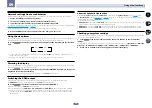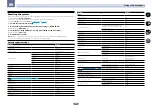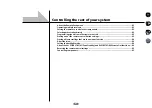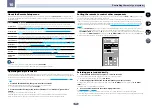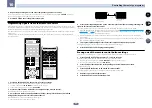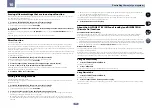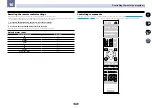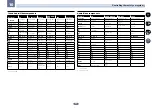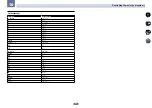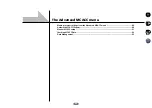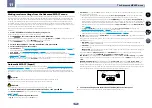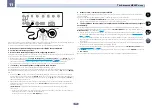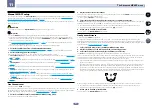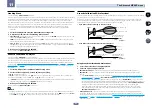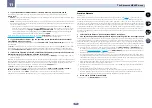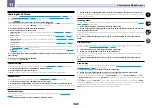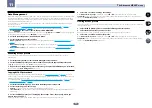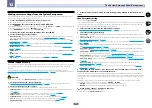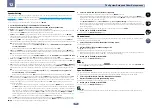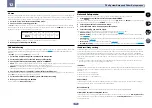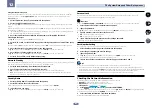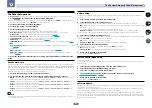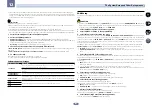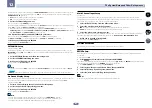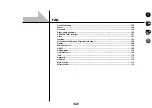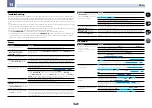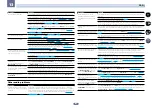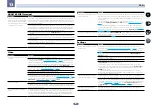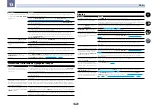
93
11
The Advanced MCACC menu
3 If you selected ‘Reverb Measurement’, select EQ ON or EQ OFF, and then START.
The following options determine how the reverb characteristics of your listening area are displayed in
Reverb View
:
!
EQ OFF
– You will see the reverb characteristics of your listening area without the equalization performed by
this receiver (before calibration).
!
EQ ON
– You will see the reverb characteristics of your listening area with the equalization performed by this
receiver (after calibration). Note that the EQ response may not appear entirely flat due to adjustments neces-
sary for your listening area.
—
The calibration corresponding to the currently selected MCACC preset will be used when
EQ
ON
is
selected. To use another MCACC preset, press
MCACC
to select the MCACC memory you want to store.
—
After auto calibration with
EQ Type
:
SYMMETRY
(
Full Auto MCACC
, etc.), the graph for the inferred
reverb characteristics can be displayed by selecting
Reverb View
. To display the actually measured
reverb characteristics after EQ calibration, measure with
EQ ON
.
When the reverb measurement is finished, you can select
Reverb View
to see the results on-screen. See
Professional Calibration EQ graphical output
on
page 108
for troubleshooting information.
4 If you selected ‘Reverb View’, you can check the reverb characteristics for each channel.
Press RETURN when you’re done.
The reverb characteristics are displayed when the
Full Auto MCACC
or
Reverb Measurement
measurements
are conducted.
Use
k
/
l
to select the channel, frequency and calibration setting you want to check. Use
i
/
j
to go back and
forth between the three. The reverb characteristics graph before and after EQ calibration can be displayed by
selecting
Calibration
:
Before
/
After
. Note that the markers on the vertical axis indicate decibels in 2 dB steps.
5 If ‘Advanced EQ Setup’ is selected, select the MCACC memory to be stored, then enter the
desired time setting for calibration, and then select START.
!
To specify the place where the MCACC memory is to be stored, press
MCACC
to select the MCACC memory
you want to store.
Based on the reverb measurement above, you can choose the time period that will be used for the final frequency
adjustment and calibration. Even though you can make this setting without reverb measurement, it is best to use
the measurement results as a reference for your time setting. For an optimal system calibration based on the
direct sound coming from the speakers, we recommend using the
30-50ms
setting.
Use
k
/
l
to select the setting. Use
i
/
j
to switch between them.
Select the setting from the following time periods (in milliseconds):
0-20ms
,
10-30ms
,
20-40ms
,
30-50ms
,
40-60ms
,
50-70ms
and
60-80ms
. This setting will be applied to all channels during calibration.
When you’re finished, select
START
. It will take about 2 to 4 minutes for the calibration to finish.
After the Acoustic Calibration Equalization is set, you are given the option to check the settings on-screen.
Precision Distance
SC-LX86 only
Before using this function, perform the Full Auto MCACC Setup procedure (see
page 45
). Performing the Full
Auto MCACC procedure corrects the distance to a precision of 1 cm, but the Precision Distance function lets
you adjust the distance to the speakers (their position) with a precision of under 1 cm. Here, rather than correct
the numerical value of the distance, actually move the physical positions of the speakers to fine-adjust (the sub-
woofer cannot be adjusted). The input from the microphone is indicated on the screen. Fine-adjust the positions
of the speakers so that the gauge reading is maximum. The detailed distance adjustments that were previously
performed by skilled installers by ear can easily be performed watching the gauge on the monitor. Place the
microphone in the same position as when the microphone was connected and the Full Auto MCACC operation
was performed.
1 Select ‘Precision Distance’ from the Manual MCACC setup menu.
2 Fine-adjust the positions of the speakers in sequence, starting from the front right channel.
Test pulses are output from the speaker for the selected channel and from one other speaker. Move the position
of the selected speaker 1 cm towards or away from the microphone. Watch the screen when doing so, and fine-
adjust the positions of the speakers so that the gauge reading is maximum. Also, the channel serving as the stan-
dard differs according to the channel being adjusted. Do not move the speaker serving as the standard channel.
The maximum gauge reading is 10.0. (If the reading stays under 10.0, adjust the speaker for the maximum value.)
!
If the microphone is placed in a different position from when the
Full Auto MCACC
or
Auto MCACC
proce-
dure was performed, it may not be possible to adjust properly. In this case, we recommend performing the
procedure at
Fine Speaker Distance
on
page 91
Manual MCACC
measurements, then performing the
adjustment described here without moving the microphone.
!
The adjustment here is for adjusting for an error of 1 cm or less (not adjustable with the Auto MCACC Setup).
0.0 may be displayed after distance correction with the Auto MCACC Setup, but even in this case this adjust-
ment allows you to optimize the correction. Note that if the Auto MCACC Setup is performed after completing
the fine-adjustment here, the correction precision will drop to about 1 cm.
!
Like with the Auto MCACC Setup, perform this adjustment in as quiet an environment as possible. 0.0 will be
displayed if abrupt noise is input during the adjustment.
!
The distance for all the channels can only be made uniform even if the
R
(front right) channel is adjusted in
the proper order.
!
Be very careful not to tip the speakers over when moving them.
!
The result of the adjustment performed here can be checked by listening to the test pulses output at the
Precision Distance (the test pulses will be more centrally positioned between the speakers than before the
adjustment was performed). Be careful not to change the distance values at this time.
3 When you’re finished, press RETURN.
You will return to the
Manual MCACC
setup menu.

